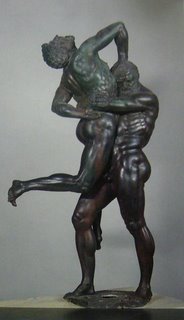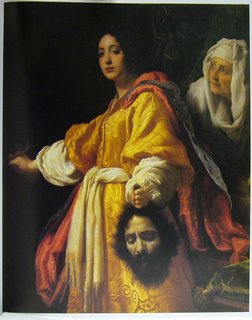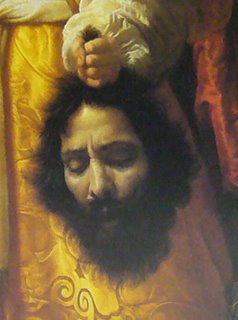Age of the Medici
About three years ago, the museum hosted one of my favorite shows of all-time --- primarly due to the inclusion of the following two objects:

In the 1540's, to celebrate the consilidation of their autocratic control over Florence (and the duchy of Tuscany)-- the Medici family began planning for a monument to brute force -- centering on the depiction of Hercules and Anteus set into a fountain. After several false-starts, Nicolo Tribolo was chosen to design the monument, and Ammanati to make the broze figures, completed in 1559.

What an incredible masterpiece ! The power that ripples through every joint and tendon -- connecting to a majestic, awesome, symphonic unity. I went to stare at it every week it was on display. It's brutal -- monstrous -- dynamic --- relentless -- just like the modern secular states that eventually would dominate world history.
Ammanati -- you rule ! -- and much longer, and much better, than the Medici ever did.

Then there was this masterpiece by Christofano Allori (1557-1621) painted near the end of his life in 1616-18. Christofano was almost an exact contemporary of Caravaggio -- and like any other painter in his right mind -- followed the lead of that incredible genius -- into a world of dark, dramatic, sordid passions.

The story, as you must have guessed, celebrates that most notorious femme fatale, Judith, and her lover/victim, Holofernes, who touched her flesh just once -- and
immediately lost his head. Above is a detail of that crafty Jewess, Judith -- which, according to historians, is also a portrait of Christofano's young lover.

And this is a detail of poor Holofernes -- the great Iraqi general -- which is also said to be a portrait of the artist himself -- an aging devotee to the muse -- who also lost his head to a striking young woman. Look at the languor in her eyes -- and look at the severed power of his head -- and it tells a story that is tragic -- but not necesssarily one that should be considered cautionary.

In the 1540's, to celebrate the consilidation of their autocratic control over Florence (and the duchy of Tuscany)-- the Medici family began planning for a monument to brute force -- centering on the depiction of Hercules and Anteus set into a fountain. After several false-starts, Nicolo Tribolo was chosen to design the monument, and Ammanati to make the broze figures, completed in 1559.

What an incredible masterpiece ! The power that ripples through every joint and tendon -- connecting to a majestic, awesome, symphonic unity. I went to stare at it every week it was on display. It's brutal -- monstrous -- dynamic --- relentless -- just like the modern secular states that eventually would dominate world history.
Ammanati -- you rule ! -- and much longer, and much better, than the Medici ever did.

Then there was this masterpiece by Christofano Allori (1557-1621) painted near the end of his life in 1616-18. Christofano was almost an exact contemporary of Caravaggio -- and like any other painter in his right mind -- followed the lead of that incredible genius -- into a world of dark, dramatic, sordid passions.

The story, as you must have guessed, celebrates that most notorious femme fatale, Judith, and her lover/victim, Holofernes, who touched her flesh just once -- and
immediately lost his head. Above is a detail of that crafty Jewess, Judith -- which, according to historians, is also a portrait of Christofano's young lover.

And this is a detail of poor Holofernes -- the great Iraqi general -- which is also said to be a portrait of the artist himself -- an aging devotee to the muse -- who also lost his head to a striking young woman. Look at the languor in her eyes -- and look at the severed power of his head -- and it tells a story that is tragic -- but not necesssarily one that should be considered cautionary.


2 Comments:
Two of the AIC's studies of Judith and Holofernes I know. The sweeter one by Ficherelli with Judith in a blue gown, dressed as if she's going out shopping, and the bodybuilder slayer of generals by Hemessen, which shows Judith nude from behind and rippling with muscles. The latter I've been unable to find in the AIC's online catalogue even though it's one of the more arressting works in the whole musuem.
Wow! When was the last time this blog had such an exciting visitor? And .. you've even told me what I need to hunt for next time I'm in the museum's database (they're still working on it)
Stop by Mountshang some time -- that's where I'm doing museum visits these days -- while I turn this A.I.C. blog over to museum history.
Post a Comment
<< Home